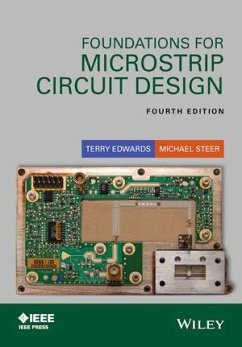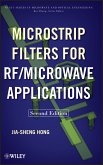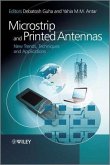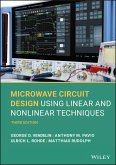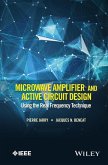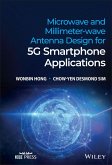

Alle Infos zum eBook verschenken

- Format: ePub
- Merkliste
- Auf die Merkliste
- Bewerten Bewerten
- Teilen
- Produkt teilen
- Produkterinnerung
- Produkterinnerung

Hier können Sie sich einloggen

Bitte loggen Sie sich zunächst in Ihr Kundenkonto ein oder registrieren Sie sich bei bücher.de, um das eBook-Abo tolino select nutzen zu können.
Building on the success of the previous three editions, Foundations for Microstrip Circuit Design offers extensive new, updated and revised material based upon the latest research. Strongly design-oriented, this fourth edition provides the reader with a fundamental understanding of this fast expanding field making it a definitive source for professional engineers and researchers and an indispensable reference for senior students in electronic engineering. Topics new to this edition: microwave substrates, multilayer transmission line structures, modern EM tools and techniques, microstrip and…mehr
- Geräte: eReader
- mit Kopierschutz
- eBook Hilfe
- Größe: 49.77MB
![Microstrip Filters for RF / Microwave Applications (eBook, ePUB) Microstrip Filters for RF / Microwave Applications (eBook, ePUB)]() Jia-Sheng HongMicrostrip Filters for RF / Microwave Applications (eBook, ePUB)159,99 €
Jia-Sheng HongMicrostrip Filters for RF / Microwave Applications (eBook, ePUB)159,99 €![Foundations of Applied Electrodynamics (eBook, ePUB) Foundations of Applied Electrodynamics (eBook, ePUB)]() Wen GeyiFoundations of Applied Electrodynamics (eBook, ePUB)98,99 €
Wen GeyiFoundations of Applied Electrodynamics (eBook, ePUB)98,99 €![Microstrip and Printed Antennas (eBook, ePUB) Microstrip and Printed Antennas (eBook, ePUB)]() Microstrip and Printed Antennas (eBook, ePUB)116,99 €
Microstrip and Printed Antennas (eBook, ePUB)116,99 €![Microwave Circuit Design Using Linear and Nonlinear Techniques (eBook, ePUB) Microwave Circuit Design Using Linear and Nonlinear Techniques (eBook, ePUB)]() George D. VendelinMicrowave Circuit Design Using Linear and Nonlinear Techniques (eBook, ePUB)149,99 €
George D. VendelinMicrowave Circuit Design Using Linear and Nonlinear Techniques (eBook, ePUB)149,99 €![Optoelectronic Integrated Circuit Design and Device Modeling (eBook, ePUB) Optoelectronic Integrated Circuit Design and Device Modeling (eBook, ePUB)]() Jianjun GaoOptoelectronic Integrated Circuit Design and Device Modeling (eBook, ePUB)111,99 €
Jianjun GaoOptoelectronic Integrated Circuit Design and Device Modeling (eBook, ePUB)111,99 €![Microwave Amplifier and Active Circuit Design Using the Real Frequency Technique (eBook, ePUB) Microwave Amplifier and Active Circuit Design Using the Real Frequency Technique (eBook, ePUB)]() Pierre JarryMicrowave Amplifier and Active Circuit Design Using the Real Frequency Technique (eBook, ePUB)105,99 €
Pierre JarryMicrowave Amplifier and Active Circuit Design Using the Real Frequency Technique (eBook, ePUB)105,99 €![Microwave and Millimeter-wave Antenna Design for 5G Smartphone Applications (eBook, ePUB) Microwave and Millimeter-wave Antenna Design for 5G Smartphone Applications (eBook, ePUB)]() Wonbin HongMicrowave and Millimeter-wave Antenna Design for 5G Smartphone Applications (eBook, ePUB)111,99 €
Wonbin HongMicrowave and Millimeter-wave Antenna Design for 5G Smartphone Applications (eBook, ePUB)111,99 €-
-
-
Dieser Download kann aus rechtlichen Gründen nur mit Rechnungsadresse in A, B, BG, CY, CZ, D, DK, EW, E, FIN, F, GR, HR, H, IRL, I, LT, L, LR, M, NL, PL, P, R, S, SLO, SK ausgeliefert werden.
- Produktdetails
- Verlag: John Wiley & Sons
- Seitenzahl: 688
- Erscheinungstermin: 1. Februar 2016
- Englisch
- ISBN-13: 9781118936177
- Artikelnr.: 44633696
- Verlag: John Wiley & Sons
- Seitenzahl: 688
- Erscheinungstermin: 1. Februar 2016
- Englisch
- ISBN-13: 9781118936177
- Artikelnr.: 44633696
- Herstellerkennzeichnung Die Herstellerinformationen sind derzeit nicht verfügbar.
Acknowledgements xxv
1 Introduction to Design Using Microstrip and Planar Lines 1
1.1 Introduction 1
1.2 Origins of Microstrip 2
1.3 RF and Microwave Modules 4
1.4 Interconnections on RF and Microwave Integrated Circuits 13
1.5 High-speed Digital Interconnections 15
1.6 Summary 18
References 18
2 Fundamentals of Signal Transmission on Interconnects 19
2.1 Introduction 19
2.2 Transmission Lines and Interconnects 19
2.3 Interconnects as Part of a Packaging Hierarchy 20
2.4 The Physical Basis of Interconnects 21
2.5 The Physics, a Guided Wave 23
2.6 When an Interconnect Should be Treated as a Transmission Line 32
2.7 The Concept of RF Transmission Lines 34
2.8 Primary Transmission Line Constants 34
2.9 Secondary Constants for Transmission Lines 35
2.10 Transmission Line Impedances 37
2.11 Reflection 38
2.12 Multiple Conductors 41
2.13 Return Currents 44
2.14 Modeling of Interconnects 47
2.15 Summary 49
References 50
3 Microwave Network Analysis 51
3.1 Introduction 51
3.2 Two-port Networks 51
3.3 Scattering Parameter Theory 55
3.4 Signal-flow Graph Techniques and S Parameters 70
3.5 Summary 74
References 74
4 Transmission Line Theory 76
4.1 Introduction 76
4.2 Transmission Line Theory 76
4.3 Chain (ABCD) Parameters for a Uniform Length of Loss-free Transmission
Line 81
4.4 Change in Reference Plane 82
4.5 Working With a Complex Characteristic Impedance 83
4.6 Summary 87
References 88
5 Planar Interconnect Technologies 89
5.1 Introductory Remarks 89
5.2 Microwave Frequencies and Applications 89
5.3 Transmission Line Structures 91
5.4 Substrates for Planar Transmission Lines 98
5.5 Thin-film Modules 102
5.6 Thick-film Modules 104
5.7 Monolithic Technology 105
5.8 Printed Circuit Boards 108
5.9 Multichip Modules 111
5.10 Summary 116
References 117
6 Microstrip Design at Low Frequencies 120
6.1 The Microstrip Design Problem 120
6.2 The Quasi-TEM Mode of Propagation 122
6.3 Static-TEM Parameters 124
6.4 Effective Permittivity and Characteristic Impedance of Microstrip 127
6.5 Filling Factor 132
6.6 Approximate Graphically Based Synthesis 134
6.7 Formulas for Accurate Static-TEM Design Calculations 137
6.8 Electromagnetic Analysis-based Techniques 139
6.9 A Worked Example of Static-TEM Synthesis 140
6.10 Microstrip on a Dielectrically Anisotropic Substrate 141
6.11 Microstrip and Magnetic Materials 146
6.12 Effects of Finite Strip Thickness, Metallic Enclosure, and
Manufacturing Tolerances 147
6.13 Pulse Propagation along Microstrip Lines 151
6.14 Recommendations Relating to the Static-TEM Approaches 152
6.15 Summary 154
References 155
7 Microstrip at High Frequencies 157
7.1 Introduction 157
7.2 Frequency-dependent Effects 157
7.3 Approximate Calculations Accounting for Dispersion 169
7.4 Accurate Design Formulas 173
7.5 Effects due to Ferrite and to Dielectrically Anisotropic Substrates 182
7.6 Field Solutions 183
7.7 Frequency Dependence of Microstrip Characteristic Impedance 186
7.8 Multimoding and Limitations on Operating Frequency 190
7.9 Design Recommendations 194
7.10 Summary 196
References 196
8 Loss and Power-dependent Effects in Microstrip 200
8.1 Introduction 200
8.2 Q Factor as a Measure of Loss 200
8.3 Power Losses and Parasitic Effects 208
8.4 Superconducting Microstrip Lines 216
8.5 Power-handling Capabilities 219
8.6 Passive Intermodulation Distortion 221
8.7 Summary 224
References 224
9 Discontinuities in Microstrip 227
9.1 Introduction 227
9.2 The Main Discontinuities 228
9.3 Bends in Microstrip 236
9.4 Step Changes in Width (Impedance Step) 241
9.5 The Narrow Transverse Slit 243
9.6 Microstrip Junctions 245
9.7 Recommendations for the Calculation of Discontinuities 261
9.8 Summary 266
References 266
10 Parallel-coupled Microstrip Lines 268
10.1 Introduction 268
10.2 Coupled Transmission Line Theory 269
10.3 Formulas for Characteristic Impedance of Coupled Lines 278
10.4 Semi-empirical Analysis Formulas as a Design Aid 290
10.5 An Approximate Synthesis Technique 301
10.6 Summary 304
References 304
11 Applications of Parallel-coupled Microstrip Lines 306
11.1 Introduction 306
11.2 Directional Couplers 306
11.3 Design Example: Design of a 10 dB Microstrip Coupler 308
11.4 Frequency- and Length-Dependent Characteristics of Directional
Couplers 310
11.5 Special Coupler Designs with Improved Performance 315
11.6 Thickness Effects, Power Losses, and Fabrication Tolerances 329
11.7 Choice of Structure and Design Recommendations 331
11.8 Summary 336
References 337
12 Microstrip Passive Elements 339
12.1 Introduction 339
12.2 Lumped Elements 339
12.3 Terminations and Attenuators 343
12.4 Microstrip Stubs 345
12.5 Hybrids and Couplers 348
12.6 Power Combiners and Dividers 355
12.7 Baluns 357
12.8 Integrated Components 359
12.9 Summary 365
References 365
13 Stripline Design 369
13.1 Introduction 369
13.2 Symmetrical Stripline 370
13.3 Asymmetrical Stripline 373
13.4 Suspended Stripline 375
13.5 Coupled Stripline 375
13.6 Double-sided Stripline 379
13.7 Discontinuities 380
13.8 Design Recommendations 381
13.9 Summary 382
References 382
14 CPW Design Fundamentals 384
14.1 Introduction to Properties of Coplanar Waveguide 384
14.2 Modeling CPWs 389
14.3 Formulas for Accurate Calculations 391
14.4 Loss Mechanisms 393
14.5 Dispersion 397
14.6 Discontinuities 408
14.7 Circuit Elements 421
14.8 Variants on the Basic CPW Structure 430
14.9 Summary 439
References 439
15 Slotline 443
15.1 Introduction 443
15.2 Basic Concept and Structure 444
15.3 Operating Principles and Modes 444
15.4 Propagation and Dispersion Characteristics 447
15.5 Evaluation of Guide Wavelength and Characteristic Impedance 451
15.6 Losses 453
15.7 End-effects: Open Circuits and Short Circuits 455
15.8 Summary 463
References 463
16 Slotline Applications 465
16.1 Introduction 465
16.2 Comparators and Couplers 465
16.3 Filter Applications 472
16.4 Magic T 474
16.5 The Marchand Balun 477
16.6 Phase Shifters 480
16.7 Isolators and Circulators 481
16.8 A Double-sided, Balanced Microwave Circuit 486
16.9 Summary 486
References 486
17 Transitions 488
17.1 Introduction 488
17.2 Coaxial-to-microstrip Transitions 488
17.3 Waveguide-to-microstrip Transitions 490
17.4 Transitions between CPW and other Mediums 495
17.5 Slotline Transitions 498
17.6 Other Microstrip Transitions 510
17.7 Summary 511
References 511
18 Measurements of Planar Transmission Line Structures 514
18.1 Introduction 514
18.2 Instrumentation Systems for Microstrip Measurements 514
18.3 Measurement of Scattering Parameters 515
18.4 Measurement of Substrate Properties 519
18.5 Microstrip Resonator Methods 523
18.6 Q Factor Measurements 533
18.7 Measurements of Parallel-coupled Microstrips 535
18.8 Time-domain Reflectometry Techniques 537
18.9 Summary 539
References 539
19 Filters Using Planar Transmission Lines 541
19.1 Introduction 541
19.2 Filter Prototypes 541
19.3 Microstrip Filters 554
19.4 Microstrip Bandpass Filters 559
19.5 Parallel-coupled Line Bandpass Filters 561
19.6 Filter Design Accounting for Losses 572
19.7 Dielectric Resonators and Filters Using Them 572
19.8 Spurline Bandstop Filters 573
19.9 Summary 575
References 575
20 Magnetic Materials and Planar Transmission Lines 576
20.1 Introduction 576
20.2 Microwave Magnetic Materials 577
20.3 Effective Permeability of Magnetic Materials 587
20.4 Microstrip on a Ferrite Substrate 589
20.5 Isolators and Circulators 592
20.6 Transmission Lines Using Metaconductors 595
20.7 Frequency Selective Limiter 606
20.8 Summary 607
References 607
21 Interconnects for Digital Systems 610
21.1 Introduction 610
21.2 Overview of On-chip Interconnects 610
21.3 RC Modeling of On-chip Interconnects 613
21.4 Modeling Inductance 619
21.5 Clock Distribution 622
21.6 Resonant Clock Distribution 625
21.7 Summary 626
References 627
A Physical and Mathematical Properties 629
A.1 SI Units 629
A.2 SI Prefixes 629
A.3 Physical and Mathematical Constants 631
A. 4 Basis of Electromagnetic SI Units 631
A.5 Relationship of SI Units to CGS Units 632
B Material Properties 635
References 642
C RF and Microwave Substrates 643
C.1 Hard substrates 643
C.2 Soft Substrates 644
Index 647
Acknowledgements xxv
1 Introduction to Design Using Microstrip and Planar Lines 1
1.1 Introduction 1
1.2 Origins of Microstrip 2
1.3 RF and Microwave Modules 4
1.4 Interconnections on RF and Microwave Integrated Circuits 13
1.5 High-speed Digital Interconnections 15
1.6 Summary 18
References 18
2 Fundamentals of Signal Transmission on Interconnects 19
2.1 Introduction 19
2.2 Transmission Lines and Interconnects 19
2.3 Interconnects as Part of a Packaging Hierarchy 20
2.4 The Physical Basis of Interconnects 21
2.5 The Physics, a Guided Wave 23
2.6 When an Interconnect Should be Treated as a Transmission Line 32
2.7 The Concept of RF Transmission Lines 34
2.8 Primary Transmission Line Constants 34
2.9 Secondary Constants for Transmission Lines 35
2.10 Transmission Line Impedances 37
2.11 Reflection 38
2.12 Multiple Conductors 41
2.13 Return Currents 44
2.14 Modeling of Interconnects 47
2.15 Summary 49
References 50
3 Microwave Network Analysis 51
3.1 Introduction 51
3.2 Two-port Networks 51
3.3 Scattering Parameter Theory 55
3.4 Signal-flow Graph Techniques and S Parameters 70
3.5 Summary 74
References 74
4 Transmission Line Theory 76
4.1 Introduction 76
4.2 Transmission Line Theory 76
4.3 Chain (ABCD) Parameters for a Uniform Length of Loss-free Transmission
Line 81
4.4 Change in Reference Plane 82
4.5 Working With a Complex Characteristic Impedance 83
4.6 Summary 87
References 88
5 Planar Interconnect Technologies 89
5.1 Introductory Remarks 89
5.2 Microwave Frequencies and Applications 89
5.3 Transmission Line Structures 91
5.4 Substrates for Planar Transmission Lines 98
5.5 Thin-film Modules 102
5.6 Thick-film Modules 104
5.7 Monolithic Technology 105
5.8 Printed Circuit Boards 108
5.9 Multichip Modules 111
5.10 Summary 116
References 117
6 Microstrip Design at Low Frequencies 120
6.1 The Microstrip Design Problem 120
6.2 The Quasi-TEM Mode of Propagation 122
6.3 Static-TEM Parameters 124
6.4 Effective Permittivity and Characteristic Impedance of Microstrip 127
6.5 Filling Factor 132
6.6 Approximate Graphically Based Synthesis 134
6.7 Formulas for Accurate Static-TEM Design Calculations 137
6.8 Electromagnetic Analysis-based Techniques 139
6.9 A Worked Example of Static-TEM Synthesis 140
6.10 Microstrip on a Dielectrically Anisotropic Substrate 141
6.11 Microstrip and Magnetic Materials 146
6.12 Effects of Finite Strip Thickness, Metallic Enclosure, and
Manufacturing Tolerances 147
6.13 Pulse Propagation along Microstrip Lines 151
6.14 Recommendations Relating to the Static-TEM Approaches 152
6.15 Summary 154
References 155
7 Microstrip at High Frequencies 157
7.1 Introduction 157
7.2 Frequency-dependent Effects 157
7.3 Approximate Calculations Accounting for Dispersion 169
7.4 Accurate Design Formulas 173
7.5 Effects due to Ferrite and to Dielectrically Anisotropic Substrates 182
7.6 Field Solutions 183
7.7 Frequency Dependence of Microstrip Characteristic Impedance 186
7.8 Multimoding and Limitations on Operating Frequency 190
7.9 Design Recommendations 194
7.10 Summary 196
References 196
8 Loss and Power-dependent Effects in Microstrip 200
8.1 Introduction 200
8.2 Q Factor as a Measure of Loss 200
8.3 Power Losses and Parasitic Effects 208
8.4 Superconducting Microstrip Lines 216
8.5 Power-handling Capabilities 219
8.6 Passive Intermodulation Distortion 221
8.7 Summary 224
References 224
9 Discontinuities in Microstrip 227
9.1 Introduction 227
9.2 The Main Discontinuities 228
9.3 Bends in Microstrip 236
9.4 Step Changes in Width (Impedance Step) 241
9.5 The Narrow Transverse Slit 243
9.6 Microstrip Junctions 245
9.7 Recommendations for the Calculation of Discontinuities 261
9.8 Summary 266
References 266
10 Parallel-coupled Microstrip Lines 268
10.1 Introduction 268
10.2 Coupled Transmission Line Theory 269
10.3 Formulas for Characteristic Impedance of Coupled Lines 278
10.4 Semi-empirical Analysis Formulas as a Design Aid 290
10.5 An Approximate Synthesis Technique 301
10.6 Summary 304
References 304
11 Applications of Parallel-coupled Microstrip Lines 306
11.1 Introduction 306
11.2 Directional Couplers 306
11.3 Design Example: Design of a 10 dB Microstrip Coupler 308
11.4 Frequency- and Length-Dependent Characteristics of Directional
Couplers 310
11.5 Special Coupler Designs with Improved Performance 315
11.6 Thickness Effects, Power Losses, and Fabrication Tolerances 329
11.7 Choice of Structure and Design Recommendations 331
11.8 Summary 336
References 337
12 Microstrip Passive Elements 339
12.1 Introduction 339
12.2 Lumped Elements 339
12.3 Terminations and Attenuators 343
12.4 Microstrip Stubs 345
12.5 Hybrids and Couplers 348
12.6 Power Combiners and Dividers 355
12.7 Baluns 357
12.8 Integrated Components 359
12.9 Summary 365
References 365
13 Stripline Design 369
13.1 Introduction 369
13.2 Symmetrical Stripline 370
13.3 Asymmetrical Stripline 373
13.4 Suspended Stripline 375
13.5 Coupled Stripline 375
13.6 Double-sided Stripline 379
13.7 Discontinuities 380
13.8 Design Recommendations 381
13.9 Summary 382
References 382
14 CPW Design Fundamentals 384
14.1 Introduction to Properties of Coplanar Waveguide 384
14.2 Modeling CPWs 389
14.3 Formulas for Accurate Calculations 391
14.4 Loss Mechanisms 393
14.5 Dispersion 397
14.6 Discontinuities 408
14.7 Circuit Elements 421
14.8 Variants on the Basic CPW Structure 430
14.9 Summary 439
References 439
15 Slotline 443
15.1 Introduction 443
15.2 Basic Concept and Structure 444
15.3 Operating Principles and Modes 444
15.4 Propagation and Dispersion Characteristics 447
15.5 Evaluation of Guide Wavelength and Characteristic Impedance 451
15.6 Losses 453
15.7 End-effects: Open Circuits and Short Circuits 455
15.8 Summary 463
References 463
16 Slotline Applications 465
16.1 Introduction 465
16.2 Comparators and Couplers 465
16.3 Filter Applications 472
16.4 Magic T 474
16.5 The Marchand Balun 477
16.6 Phase Shifters 480
16.7 Isolators and Circulators 481
16.8 A Double-sided, Balanced Microwave Circuit 486
16.9 Summary 486
References 486
17 Transitions 488
17.1 Introduction 488
17.2 Coaxial-to-microstrip Transitions 488
17.3 Waveguide-to-microstrip Transitions 490
17.4 Transitions between CPW and other Mediums 495
17.5 Slotline Transitions 498
17.6 Other Microstrip Transitions 510
17.7 Summary 511
References 511
18 Measurements of Planar Transmission Line Structures 514
18.1 Introduction 514
18.2 Instrumentation Systems for Microstrip Measurements 514
18.3 Measurement of Scattering Parameters 515
18.4 Measurement of Substrate Properties 519
18.5 Microstrip Resonator Methods 523
18.6 Q Factor Measurements 533
18.7 Measurements of Parallel-coupled Microstrips 535
18.8 Time-domain Reflectometry Techniques 537
18.9 Summary 539
References 539
19 Filters Using Planar Transmission Lines 541
19.1 Introduction 541
19.2 Filter Prototypes 541
19.3 Microstrip Filters 554
19.4 Microstrip Bandpass Filters 559
19.5 Parallel-coupled Line Bandpass Filters 561
19.6 Filter Design Accounting for Losses 572
19.7 Dielectric Resonators and Filters Using Them 572
19.8 Spurline Bandstop Filters 573
19.9 Summary 575
References 575
20 Magnetic Materials and Planar Transmission Lines 576
20.1 Introduction 576
20.2 Microwave Magnetic Materials 577
20.3 Effective Permeability of Magnetic Materials 587
20.4 Microstrip on a Ferrite Substrate 589
20.5 Isolators and Circulators 592
20.6 Transmission Lines Using Metaconductors 595
20.7 Frequency Selective Limiter 606
20.8 Summary 607
References 607
21 Interconnects for Digital Systems 610
21.1 Introduction 610
21.2 Overview of On-chip Interconnects 610
21.3 RC Modeling of On-chip Interconnects 613
21.4 Modeling Inductance 619
21.5 Clock Distribution 622
21.6 Resonant Clock Distribution 625
21.7 Summary 626
References 627
A Physical and Mathematical Properties 629
A.1 SI Units 629
A.2 SI Prefixes 629
A.3 Physical and Mathematical Constants 631
A. 4 Basis of Electromagnetic SI Units 631
A.5 Relationship of SI Units to CGS Units 632
B Material Properties 635
References 642
C RF and Microwave Substrates 643
C.1 Hard substrates 643
C.2 Soft Substrates 644
Index 647
